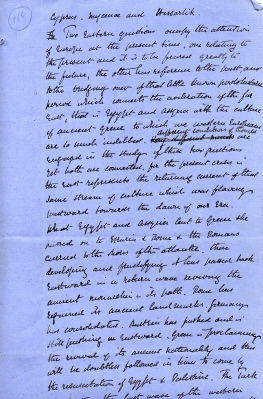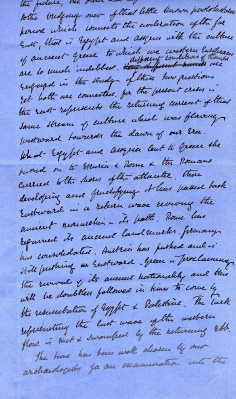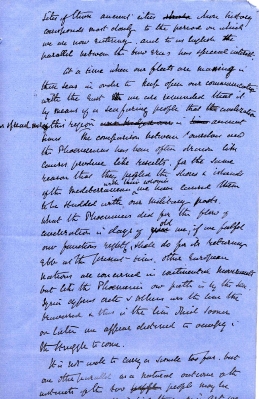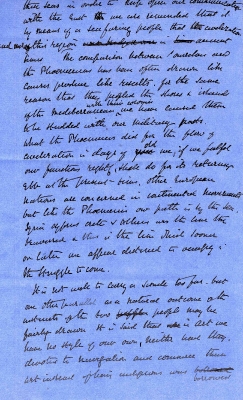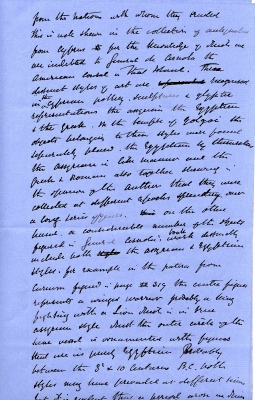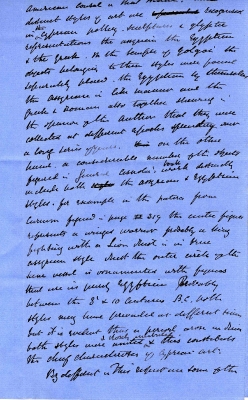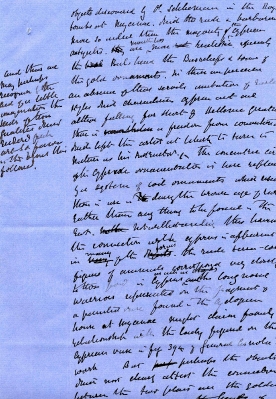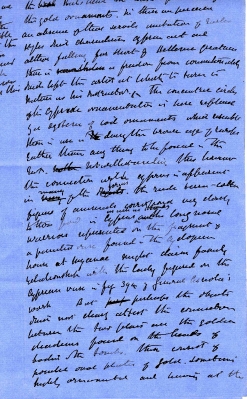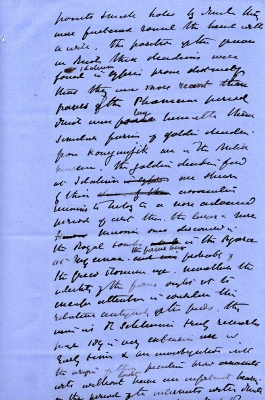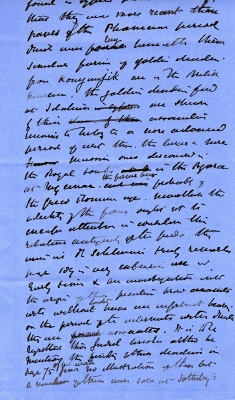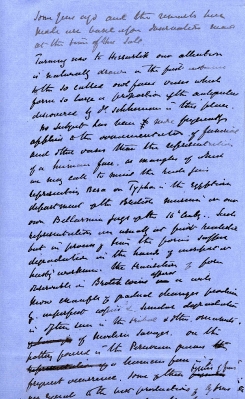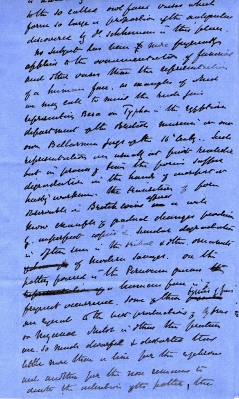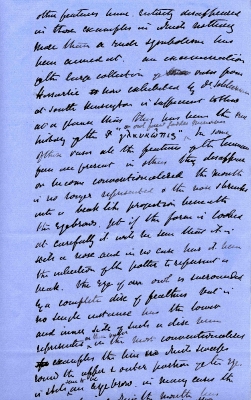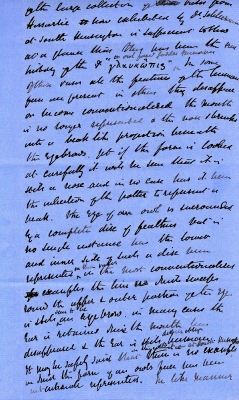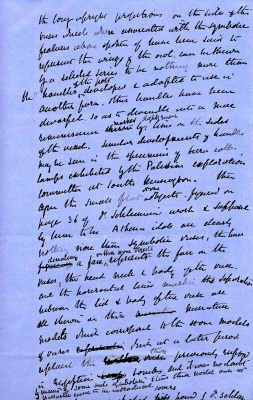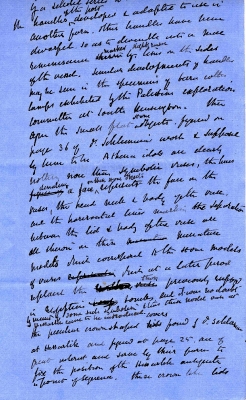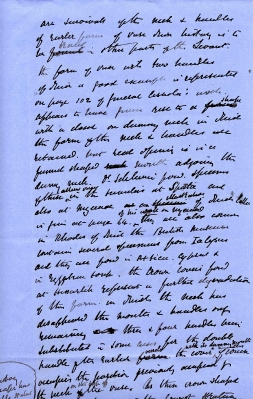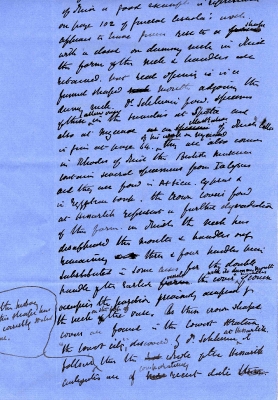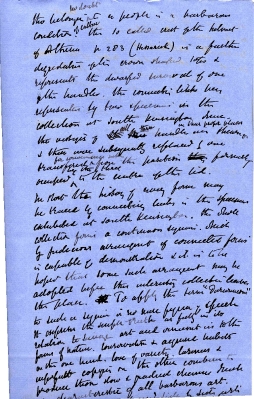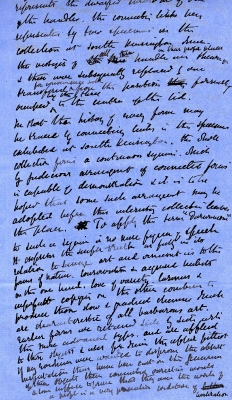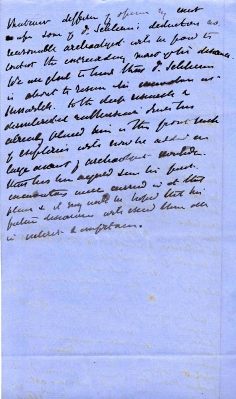To search the RPR site click here
P66 Salisbury and South Wiltshire Museum PR papers
Note that this is obviously rough notes for a paper, or talk concerning Schliemann's exhibition at South Kensington Museum by Pitt-Rivers. So far as can be worked out it was never published and it is not clear which learned society it was aimed at.
Dating: Schliemann’s finds were exhibited at SKM by January 5 1878 *, and given to ‘the German people’ in 1881, they are mentioned in the following text as though they were still in SKM when it was written and therefore it seems likely that this paper was probably written either during 1878 or before it left the museum?
The copyright of all the images on this page reside with Salisbury and South Wiltshire Museum.
Cyprus, Mycenae and Hissarlik
The Two Eastern questions occupy the attention of Europe at the present time, one relating to the present and it is to be feared greatly to the future, the other has reference to the past, and to the bridging over of that little known protohistoric period which connects the civilization of the far East, that is Egypt and Assyria with the culture of ancient Greece to which we western Europeans are so much indebted. Very different minds [insert] different conditions of thought [end insert] are engaged in the study of these two questions yet both are connected, for the present crisis in the East represents the returning current of that same stream of culture which was flowing westward towards the dawn of our Era. What Egypt and Assyria lent to Greece the [sic - then] passed on to Etruria & Rome & the Romans carried to the shores of the Atlantic, there developing and fructifying it has passed back Eastwards in a return wave reviving the ancient monarchies in its path. Rome has regained its ancient landmarks. Germany has consolidated. Austria has pushed and is still pushing Eastward. Greece is proclaiming the revival of its ancient nationality and this will be doubtless followed in times to come by the resuscitation of Egypt & Palestine. The Turk representing the last wave of the western flow is met & swamped by the returning ebb.
the time has been well chosen by our archaeologists for an examination into the sites of these ancient cities where history corresponds most closely to the period on which we are now entering, and to us English the parallel between the two eras has special interest.
At a time when our fleets are massing in these seas in order to keep open our communications with the East we are reminded that it [sic – missing word ‘was’] by means of a seafaring people that the civilization [insert] was spread in [end insert] this region and bridged over in ancient times. The comparison between ourselves and the Phoenicians has been often drawn[,] like causes produce like results. for the same reason that they peopled the shores & islands of the Mediterranean [insert] with their colonies [end insert] we have caused them to be studded with our military posts. What the Phoenicians did for the flow of civilization in days of yore [insert] old [end insert] we, if we fulfil our functions rightly, shall do for its returning ebb at the present time. other European nations are concerned in continental movements but like the Phoenecians our path is by the sea. Syria Cyprus Crete & Athens was the line that the [sic – they] traversed & this is the line which sooner or later we appear destined to occupy in the struggle to come.
It is not well to carry a simile too far. but one other parallel as a natural outcome of the activities of the two people may be fairly drawn. It is said that in Art we have no style of our own, neither had they. devoted to navigation and commerce, their art instead of being indigenous was borrowed [insert] borrowed [end insert] from the nations with whom they traded. this is well shown in the collection of antiquities from Cyprus for the knowledge of which we are indebted to General di Cesnola, the American consul in that island. These distinct styles of art are recognised in [insert] the [end insert] Cyprian pottery, sculptures & glyptic representations, the Assyrian the Egyptian & the Greek. In the temple of Golgoi the objects belonging to these styles were found separately placed. the Egyptian by themselves, the Assyrian in like manner and the Greek & Roman also together shewing in the opinion of this Author that they were collected at different epochs spreading over a long series of years. on the other hand a considerable number of the objects figured in General Cesanola’s work [insert] book [end insert] distinctly include both styles the Assyrian & Egyptian styles. for example in the patera from Curium figured in page 319 the centre figures represents a winged warrior probably a king fighting with a Lion which is in true assyrian style, whilst the outer circle of the same vessel is ornamented with figures that are as purely Egyptian. Probably between the 8 and 10 centuries B.C both styles may have prevailed at different times but it is evident that a period arose in which both styles were united [insert] & closely interacted [end insert] & this contributes the chief characteristics of Cyprian art.
Very different in this respect are some of the objects discovered by Dr. Schliemann in the Royal tombs at Mycenae. which the rude & barbarous more so indeed than the majority of [insert] the [end insert] Cyprian artefacts they are [insert] nevertheless [end insert] more realistic especially the Bulls head Bas reliefs & some of the gold ornaments. In these we perceive an absence of those servile imitations of Earlier styles which characterizes Cyprian art and although falling far short of Hellenic creations there is a freedom from conventionality which left the artist at liberty to turn to nature as his [illegible] [insert] and thus we may perhaps recognise by the help of a little imagination the seeds of those qualities which rendered Greek art so [illegible] in the [illegible] that followed. [end insert] The concentric circles of the Cyprian ornamentation is here influenced by a system of coil ornaments which resemble those in use in the during the bronze age of Europe rather than any thing to be found in the East notwithstanding of this however the connection with Cyprus is apparent in [insert] many [end insert] of the objects [insert] forms [end insert] the rude terra-cotta figures of animals correspond very closely to those found in Cyprus [insert] as well as [end insert] and the long nosed warriors represented on the fragment of a painted vase found in the Cyclopean house at Mycenae might claim family relationship with the lady figured on the Cyprian vase in fig 394 of General Cesnola’s work. But perhaps the objects which most clearly attest the connection between the two places are the golden diadems found on the heads of bodies in the tombs. these consist of pointed oval plates of gold. sometimes highly ornamented and having at the points small holes by which they were fastened round the head with a wire. the position of the graves in which these diadems were found [insert] Idalium [end insert] in Cyprus prove distinctly that they were more recent than graves of the Phoenician period which were found [insert] lay beneath These similar forms of golden diadems from Kouyunjik are in the British Museum. The golden diadem found at Idalium in Cyprus are shewn by their shown by them [illegible] remains to belong to a more advanced period of art than the larger & more [illegible] ones discovered in the Royal tombs at in the Agora at Mycenae. and in [insert] the forms being [end insert] probably of the Greco Roman age. nevertheless the [illegible] of the forms ought not to escape attention in considering the relations [illegible] of the finds. the [2 words illegible] Dr. Schliemann truly resembles page 189 in very extensive use in Early terms & an investigation into the origin of their peculiar brow ornaments will without [insert] doubt [end insert] have an important bearing on the period of the [illegible] with which they are associated. It is to be regretted that General Cesnola although he mentions the finding of these diadems on page 75 [insert] of his work [end insert] gives no illustration of them but a number of them were sold at Sotheby’s some years ago and the remarks here made are based upon observations made at the time of their sale.
Turning now to Hissarlik our attention is naturally drawn to the finds instance to the so called owl faced vases which form so large a proportion of the antiquities discovered by Dr. Schliemann in this place.
No subject has been more frequently applied to the ornamentation of funeral and other vases than the representation of a human face. an example of which we may call to mind the rude jars representing Besa on Typhon in the Egyptian department of the British Museum, or our own Bellarmine jugs of the 16th century. Such representations are usually at first realistic but in process of time the forms suffer degradation in the hands of [3 words illegible] workmen. the transition of form observable on British coins offered a well known example of gradual changes produced by imperfect copies & similar degradation is often seen in the tribal and other ornaments of savages of Modern savages. On the pottery found in the Peruvian graves the representation of a human face is of frequent occurrence. some of these [illegible] of faces are equal to the best representations of Cyprus or Mycenae whilst in others the features are so much dwarfed & distorted that little more than a line for the eyebrows and another for the nose remains to denote the intention of the potter, the other features have entirely disappeared in those examples in which nothing more than a rude symbolism has been aimed at. an examination of the large collection of vases from Hissarlik now exhibited by Dr. Schliemann at South Kensington is sufficient to shew at a glance that this has been the true history of the “γλαυκωπις” [insert] or owl faced Goddess Minerva [end insert] In some of these vases all the features of the human face are present in others they disappear or become conventionalized, the mouth is no longer represented & the nose shrinks into a beak like proportion beneath the eyebrows. yet if the form is looked at carefully it will be seen that it is still a nose and in no case has it been the intention of the potter to represent a beak. the eye of an owl is surrounded by a complete disc of feathers but in no single instance has the lower and inner side of such a disc been represented [insert] on these vases [end insert] in the most conventionalised examples the line which sweeps round the upper & outer portion of the eye is [illegible] [insert] seen to be [end insert] an eyebrow. in many cases the ear is retained while the mouth has disappeared & the ear is still [insert] distinctly [end insert] human. It may be safely said that [insert] in the collection at South Kensington [end insert] there is no example in which the form of an owls face has been intentionally represented. In like manner the long upright projections on the side of the vases which where associated with the symbolic features above spoken of have been said to represent the wings of the owl can be shewn by a selected series to be nothing more than [insert] the [end insert] handles [insert] of the pots [end insert] developed & adapted to use in another form. other handles have been dwarfed so as to [illegible d…] into a more reminscence [insert] marked [end insert] by [insert] slightly [illegible] [end insert] lines on the sides of the vessel. similar developments of handles may be seen in the specimens of terra cotta lamps exhibited by the Palestine exploration committee at South Kensington. then after the small flat [insert] stone [end insert] objects figured on page 36 of Dr. Schliemann’s work and supposed by him to be Athena idols are clearly nothing more than symbolic vases, the lines figures of [insert] denoting [end insert] a face [insert] on them some objects [end insert] represent the face on the vases, the head neck & body of the vase and the horizontal lines marking the separation between the lid & body of the vase are all shewn in these miniature models which correspond to the stone models of vases referred to which at a later period replace them. Previously [illegible] in Egyptian tombs and it was no doubt by means of some such symbolism that these model vases at Hissarlik came to be introduced.
the peculiar crown shaped lids [insert] covers [end insert] found by Dr. Schliemann at Hissarlik and figured at page 25 are of great interest and serve by their form to fix the position of the Hissarlik antiquities in point of sequence. these crown like lids are survivals of the neck & handles of earlier forms of vase whose history is to be found [insert] traced [end insert] in other parts of the Levant. the form of vase with two handles of which a good example is represented on page 102 of General Cesnola’s work appears to have given rise to a [insert] shape [end insert] with a closed or dummy neck in which the form of the neck & handles are retained but real opening is in a funnel shaped mouth adjoining the dummy neck. Dr. Schliemann found specimens of these [insert] other vases [end insert] in the tumulus at Spata and also at Mycenae an specimen [insert] illustration [end insert] of which [insert] latter [end insert] is found at page 64 [insert] of his work on Mycenae [end insert] there use also covers in Rhodes of which the British Museum contain several specimens from Ialysus and they are found in Attica. Cyprus & in Egyptian tombs. The crown covers found at Hissarlik represent a further degradation of this form in which the neck has disappeared the mouth & handles only remaining three & four handles being substituted in some cases for the double handle of the earlier form [insert] vessels [end insert] the cover [insert] with its dummy mouth and handles [end insert] of course occupies the position previously occupied of the neck [insert] on the top of [end insert] the vase. As these crown shaped covers are focused in the lowest stratum “the lowest city”, discovered by Dr. Schliemann [insert] at Hissarlik [end insert] it follows [insert] If the history of this shape has been correctly stated above [end insert] that the whole of the Hissarlik antiquities are of [insert] comparatively [end insert] recent date than tho belonging [insert] no doubt [end insert] to a people in a barbarous condition [insert] of culture [end insert] the so called crest of the helmet of Athena p 283 (Hissarlik) is a further degradation of the crown shaped tops & represents the dwarfed survival of one of the handles. the connecting links being represented by two specimens in the collection at South Kensington where the vestiges of [insert] all three [end insert] handles are shewn [insert] in their proper places [end insert] & these were subsequently replaced one transferred [insert] for convenience sake [end insert] from the position formerly occupied [insert] by the three [end insert] in the centre of the lid.
In short the history of every form may be traced by connecting links in the specimens exhibited at South Kensington. the whole collection forms a continuous sequence which by judicious arrangement of connected forms is capable of demonstration & it is to be hoped that some such arrangement may be adopted before this interesting collection leaves the place. To apply the term “Darwinism” to such a sequence is no mere figure of speech It expresses the simple truth are fully in its relation to savage art and ornament as to the forms of nature. Conservatism & acquired habits on the one hand. love of variety laziness and [illegible] copying on the other combine to produce those slow & gradual changes which are characteristic of all barbarous art. earlier forms are retained side by side with the more advanced types and are applied to those objects & uses for which they appear fittest If my evidence were wanted to disprove the absent imperfections that have been lost on the [illegible] of these objects then connected varieties would alone suffice to prove that they were the work of a people of a very primitive condition of culture [insert] civilisation [end insert]
Whatever difference of opinion may exist upon some of Dr. Schliemann’s deductions no reasonable archaeologist will be found to contest the exceeding merit of his [illegible] We are glad to hear that Dr. Schliemann is about to resume his excavation at Hissarlik. to the deep research & [2 words illegible] which has already placed him in the front reach of explorers will now be added a large amount of archaeological knowledge that has been acquired since his first excavations were accessed in at that place & it may well be hoped that his future discoveries will exceed them all in interest & [illegible]
The first draft of this was transcribed by Cristina Rose (a volunteer in the Museum) and Alice Stevenson, Alison Petch also transcribed some unreadable sections, but it will be noted that there are still some illegible sections above which is why the scans of the paper have also been included.
Unfortunately Pitt-Rivers always wrote drafts on blue foolscap sized paper, and the scanner available to the project was not large enough to scan the entire page in one go, so each page is shown in two overlapping halves, top and bottom. In one instance Pitt-Rivers wrote to both margins and the very edges could not be scanned, our apologies for these deficiencies. September 2011
* Eatwell, 2000, according to this source, Schliemann’s exhibit was the most important loan to SKM in 1878.

